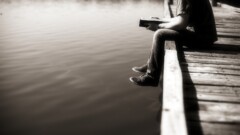Yesterday I posted the first portion of an interview with Devin Brown, author of Inside Prince Caspian and Inside Narnia. Today we continue with the second and final piece, and look at mistakes people make when reading the Narnia books and the film adaptations of Lewis’s works.
TC: What are some of the most common mistakes people make when reading and interpreting the Narnia books?
In my opinion, the two biggest mistakes people make about the Narnia books are 1) reading them in the wrong order and 2) labeling them as Christian allegory.
During Lewis’s life, The Lion, the Witch and the Wardrobe was always the first book and The Magician’s Nephew was always sixth. A number of years after Lewis passed away, the series was renumbered by the publisher and put in chronological order with The Magician’s Nephew first. While this reordering may seem to have a certain common sense appropriateness, I think the stories are best enjoyed in their original order.
If we read The Lion, the Witch and the Wardrobe first, we know only what the children do, and this allows us to journey with them. In addition, if we read The Magician’s Nephew later, it is much more satisfying. We get to say, “Oh, so that’s where the lamp-post came from!”
When the film Susan steps into Narnia, she is filled with awe and stammers, “Impossible.” If we know only what she knows, we share her wonder. But if we already know about Narnia, we say, “Oh no, Susan, it’s not impossible.”
I used to think the renumbering issue was just something Lewis scholars worried about—among Lewis experts there is a strong preference for the original order. But recently I have been talking to young people who say they had a hard time getting into the Narnia stories. I couldn’t understand the problem until I realized that because of the new numbering, they had started with The Magician’s Nephew. It is interesting to note that the filmmakers have decided to go back to the original order.
An allegory is a story whose surface elements have a clear one-to-one relationship with a second deeper story. In an allegory it is this second story, not the first, which is the real focus. A good example of an allegory is Pharaoh’s dream of the seven fat and seven thin cattle.
People often say that the Narnia books are allegorical, but technically they are not. Aslan, for example is a Christ-figure but not the same as Jesus in our world. Here’s one way they don’t line up. People sometimes say that in the same way that Jesus died for our sins, so too Aslan dies for Edmund’s sins. But in our world, we have to accept Christ’s sacrifice for our sins. In the story, Edmund is reconciled with Aslan before the death occurs. In fact, in the first book Edmund is never told that Aslan died in his place, so there is no way he could accept it.
If we try to say that Peter Pevensie is Peter the apostle, not only are we going have problems finding parallels, we do an injustice to the story. If Lewis had wanted to write a Christian allegory, he certainly could have. His earlier work The Pilgrim’s Regress is one, and was modeled after The Pilgrim’s Progress—the most famous allegory in English literature. I usually talk about the Biblical parallels that can be found in the Narnia stories, rather than allegories.
By the way, some people approach the Narnia books as if they were sermons. Again, if Lewis had wanted to write a sermon, he certainly could have done so. His sermon “The Weight of Glory,” which he preached at St. Mary’s in Oxford, is one of his most famous works. Lewis himself tells us that he wrote a fairy tale because “sometimes fairy stories may say best what’s to be said.”
TC: In your books you often compare and contrast the worlds or characters of C.S. Lewis and J.R.R. Tolkien. How valuable is it to consider the works of these men in relation to each other?
I think it is very helpful to compare elements in the Narnia stories with similar elements found elsewhere—in one of the other Chronicles, somewhere else in Lewis’s writings, or in another author’s work. Putting a scene, a character, an event, or a theme from Narnia side-by-side with a similar aspect from another book allows us to see things we might not have seen before.
A number of scholars have emphasized the differences between Lewis and Tolkien and the fact that Tolkien did not like the way Lewis mixed mythologies in Narnia. But I see these two authors as far more alike than different and sharing a deep common ground. Knowing and studying one author helps us better understand the work of the other.
TC: Did you find that the film adaptation of The Lion, the Witch and the Wardrobe helped or hindered people’s understanding of Lewis’s story and world?
I really think Walden Media’s film of The Lion, the Witch and the Wardrobe did a great job of capturing the magic, the message, and the spirit of Lewis’s original.
Everyone who loves these books was worried before the film came out because this was the one and only chance for our generation to see this story translated to the big screen. (I am thinking that, as with other great works such as Hamlet or Pride and Prejudice, each generation will produce a new version.) With the first film it became clear that not only does Andrew Adamson understand these stories, he also has a profound and genuine love for them.
Besides providing the world with an inspiring and lovingly-made movie, Walden has also encouraged many theater-goers, young and old, to go back and read or reread Lewis’s original.
TC: What was your single biggest disappointment with the film adaptation of The Lion, the Witch and the Wardrobe?
For me, the film did not quite reach either the highs or the lows that the book does, and I think this is a significant loss. In addition, I found the film Aslan to lack the awe that was always present in Lewis’s original. When the children finally meet Aslan in chapter twelve, Lewis’s narrator says, “People who have not been in Narnia sometimes think that a thing cannot be good and terrible at the same time.” The movie Aslan was good enough, but his terrible side was not as present as it needed to be.
When the children and Trumpkin meet Aslan in Prince Caspian, we are told, “They felt as glad as anyone can who feels afraid, and as afraid as anyone can who feels glad.” This will be a high mark for the second film to aim for.
If Aslan is a Christ-figure, what are we to make of this? I think Lewis was suggesting that our proper response to an encounter with Christ will be a mixture of great gladness and great awe. Some Christians may be too fearful of Jesus and so need more gladness added to their feelings. Others may have too familiar an image of Christ and may need a bit more awe.
TC: What was the one element that you felt best translated to the screen in The Lion, the Witch and the Wardrobe?
There were a number of elements that, for me, worked perfectly in the film adaptation. I thought the bombing scenes in London added greatly to the story. The Professor’s house was just the right blend of homey and spooky. Narnia in winter was as enchanted as I had hoped. And Mr. Tumnus was even better than expected. In addition, I thought that the casting was nearly perfect—especially the four children.
TC: What do you anticipate being your single biggest disappointment with Price Caspian and what is the one thing you are most looking forward to seeing on the screen?
I don’t really like to go into a film thinking I am going to be disappointed, but I wonder if the second film will get Lewis’s ending right. Lewis ends the book with the children having a newfound sense of what I call “the sacramental ordinary.” They begin the story on a “flat and dreary” train platform, but in the end they find it “unexpectedly nice is its own way.”
Lewis does not want the four children or his readers to despise their own world because they have been to Narnia. He wants them and us to better see the enchantment that has always been there. He wants our rereading of the Narnia stories to help re-enchant our lives and the world around us.
I am really looking forward to the scene in Prince Caspian where laughter and merriment returns to Narnia after having been banished or driven underground for years by Miraz. If Narnia in the first book is always winter and never Christmas, in the second book it is summertime but never the Fourth of July.
If I had to pick the greatest contribution that Lewis has made to my life, it would be his constant reminder that the Christian life should be full and overflowing with joy, laughter, celebration, and good times—not just during vacations or holidays and not just when we get to Heaven, but every day right now.
TC: Assuming that there is a movie made for each of the books, which are you most eagerly anticipating? And are you planning on writing an “Inside” book for each of the seven books and movies?
In a way this first question is really asking if I have a favorite among the Chronicles. I do, but it keeps changing—maybe this is true for everyone. While there is not a book among the seven that I don’t like, my current favorite is The Horse and His Boy, a book which I know many readers often list as their least favorite. (I wonder what this says about my taste.)
I plan to continue to write “Inside” books as long as I feel I have something to say, and so far that has not been a problem. I am currently working on Inside the Voyage of the Dawn Treader which will come out in January 2010 in advance of the third film.
Devin Brown is a Lilly Scholar and a Professor of English at Asbury College. This summer he is teaching a week-long seminar at The Kilns, where participants will get to eat, sleep, and take classes in Lewis’s home in Oxford.









